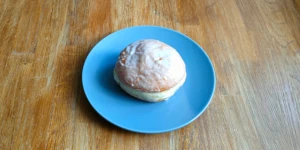
Pączki - Polish Donuts
Jump to recipe
Pączki (donuts) are unique and popular pastries, which are made of yeast dough consisting mainly of wheat flour, eggs, milk and butter. After rising, the dough is formed into slightly flattened balls and then deep-fried in fat such as lard, vegetable oil or clarified butter. You can stuff the donuts with marmalade, both before and after frying, and cover them with tasty icing. Traditionally, they are served especially during the carnival, and especially on Fat Thursday, when everyone wants to enjoy these delicious treats.
History of donuts
The history of donuts dates back to ancient Rome, but their appearance and taste were completely different from those we know today. In the past, "pączki" were crafted using bread dough and filled with either pork fat or bacon, resulting in a savory and zesty flavor. They were eaten to celebrate the end of winter and the appearance of the first signs of spring. Over the next centuries, donuts with greaves, also called pampuch, were served in Poland. Only in the Middle Ages, thanks to the activity of monks, donuts made of yeast dough appeared.
At the end of the 16th century, donuts appeared in a sweet form, although they were still significantly different from modern ones. They were extremely hard. It wasn't until the 18th century, with the widespread use of yeast, that donuts began to resemble the ones we know and love today. It is believed that one of the precursors of the modern variety of donuts was Cecylia Krapf, who ran the famous Viennese confectionery at the turn of the 17th and 18th centuries. There she served yeast balls stuffed with delicious fruit.
How to create polish donuts?
In Poland, we can find various variants of donuts - both those with a round, spherical shape, as well as those in the form of half-round pancakes. Polish donuts are also distinguished by the way they are stuffed. The filling of donuts can be varied, ranging from marmalade to delicious chocolate.
Now, I invite you to discover the best recipe for homemade donuts! Traditional, light and fluffy. The recipe may seem complicated, but it isn't. It contains many valuable tips for frying donuts that will make them perfectly prepared and delight us with their taste. So let's express our will that from now on, donuts in our kitchens will be baked by hand, enjoying the hearts of our loved ones and guests!
Recipe informations:
Ingredients
- 220 ml of milk
- 50 g of fresh yeast
- 3 tablespoons of sugar
- 500 g of wheat flour
- Pinch of salt
- 1 tablespoon of vanilla sugar
- 1 egg
- 4 yolks
- 45 g - melted and cooled butter
- 2 tablespoons of spirit
- Frying oil
- Multifruit (or strawberry, rose) marmalade, rose, strawberry, orange or cherry jam
- About 100 g of powdered sugar
- Icing (about 250 g icing sugar and 1-2 tbsp water or lemon juice)
